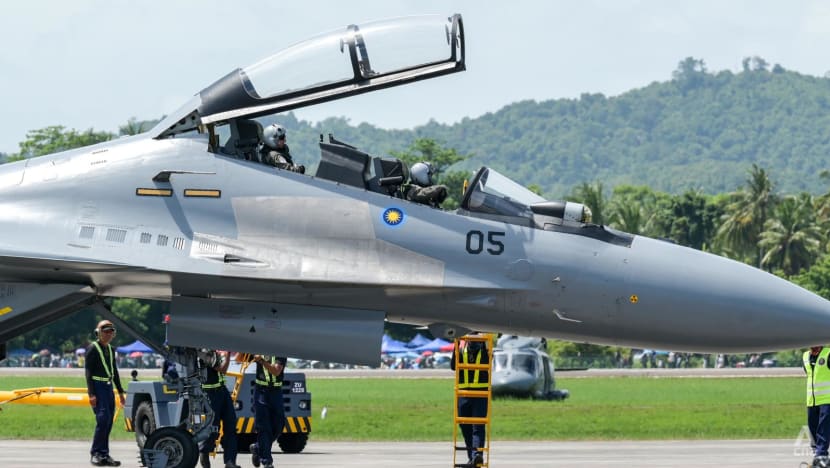Commentary: Malaysia’s fifth-generation fighter jet problem
Given its ageing fleet of fighter jets, Malaysia needs to purchase new aircraft soon. Its choices are limited, says an ISEAS – Yusof Ishak Institute academic.

Royal Malaysian Air Force Sukhoi Su-30MKM flight crew after performing at the Langkawi International Maritime and Aerospace Exhibition 2023. (Photo: CNA/Fadza Ishak)
SINGAPORE: Fortunately, the two pilots ejected safely. But the fiery crash of an F/A-18 Hornet fighter jet in Kuantan on Aug 21 brought into sharp relief a major problem facing the Royal Malaysian Air Force (RMAF): Its front-line aircraft, consisting of ageing US, UK and Russian jets, need to be replaced within the next decade.
The problem here is that Malaysia’s options for a replacement are limited; it is similarly straitened when it comes to defence spending.
The requirement is urgent. Less than a week before the crash, Malaysia’s King, Sultan Ibrahim Sultan Iskandar, had lambasted plans by the Ministry of Defence to lease four 30-year-old US-made Black Hawk helicopters, likening the aircraft to “flying coffins”.
Following the King’s unprecedented intervention, the government cancelled the US$44 million contract. Following the Kuantan crash, the same fate will almost certainly befall Malaysia’s plan to acquire 30 secondhand F/A-18 Hornets from Kuwait (which are also more than 30 years old).
MALAYSIA MUST DECIDE WHICH AIRCRAFT TO ORDER
At present, the RMAF operates seven US-made F/A-18 Hornets (delivered in 1997), 18 Russian-made Su-30MKM Flankers (delivered in 2009) and 18 UK-made Hawk fighters (delivered in 1995). All three planes are due for retirement by 2040.
The Kuwaiti Hornets were meant as a stopgap measure while Malaysia decided on a new aircraft. That decision will now have to be expedited.
Kuala Lumpur has two choices: It could order a cheaper fourth generation (non-stealthy) jet, as Thailand and the Philippines have, or a much more expensive, state-of-the-art fifth-generation stealth fighter like its neighbours Singapore and Indonesia.
According to Malaysian Defence Minister Mohamed Khaled Nordin, the government plans to equip the RMAF with fifth-generation fighters by 2040. Given the limited choices available, the question here is which one.
America’s F-35 Lightning II is tried and tested, but expensive and politically toxic given Washington’s support for Israel over its invasion of Gaza which Prime Minister Anwar Ibrahim has condemned.
China produces two kinds of stealth fighter. The J-20 Chengdu is not for sale but the J-35 Shenyang is. But as Malaysia is locked in an increasingly tense maritime territorial dispute with China in the South China Sea, this more or less rules out the J-35.
Russia is an option, but not a strong one. Moscow has been promoting its Su-57 Felon for export. But the Su-57 has serious problems. Even before Russia invaded Ukraine in 2022, Sukhoi struggled to put the aircraft into serial production (only two dozen have been built since 2020). The problem has been exacerbated by the tightening of Western sanctions and export controls.
Besides, Russian fast jets have a poor reputation in Malaysia. The RMAF retired its fleet of MiG-29s (bought only a few years before the Hornets) early due to operational problems and has had to turn to India to keep its Su-30MKM Flankers airworthy.
MALAYSIA WILL LIKELY TURN TO TÜRKIYE
A much better fit for Malaysia is the two fifth-generation fighters being developed by South Korea and Türkiye.
Korean Aerospace Industries (KAI) produces the KF-21 Boramae. It would be a logical step for Malaysia to choose the Boramae, given that the RMAF will soon gain experience flying KAI’s FA-50, a light fighter Malaysia ordered in 2023. Moreover, South Korean defence firms have established a good reputation for price, quality and speedy delivery times. Indonesia is a co-development partner for the aircraft and has ordered 48 of the jets.
But more likely, Malaysia will turn to Türkiye for its fifth-generation fighter needs. Over the past decade, Türkiye has quickly increased its share of the global arms market, and has become a particular favourite among Muslim-majority states (nine of its top ten customers are Muslim countries). Malaysia has recently ordered drones and warships from Türkiye.
Ankara has also offered Malaysia the jewel in its defence sector’s crown: the Kaan, a fifth-generation fighter that made its maiden flight last year. In July, Indonesia became the first overseas customer for the Kaan when it signed up for 48 of the aircraft to be delivered in the mid-2030s. The aircraft will be co-produced in Türkiye and Indonesia.
The Kaan is cheaper than the F-35 and technologically more advanced than the Su-57. There would be no geopolitical strings attached either. Interoperability with the Indonesian air force would be an added bonus for the RMAF as the two countries could share production, training and maintenance costs.
NEED TO INCREASE DEFENCE SPENDING
But even if Malaysia picks the Kaan, finding the money to pay for them will be problematic. Indonesia’s order is worth around US$10 billion. That works out at around US$200 million per plane when factoring in co-production, armaments and spares.
Malaysia’s defence spending, however, has stagnated. It spends only 1 per cent of gross domestic product on defence. Its 2024 defence budget was US$4.16 billion, of which only US$1.2 billion was allocated for new equipment.
Although Malaysia plans to increase its defence outlay to 1.5 per cent by 2030, this still will not be enough to put a down payment on a new fighter, let alone pay for the 36 aircraft needed to replace the RMAF’s fleet of Hornets and Flankers.
But if Malaysia is to keep up with the military capabilities of its neighbours, and provide a credible deterrent in the South China Sea where it has overlapping territorial claims with China, it will have to find a lot more money for the RMAF, and quickly.
Ian Storey is Senior Fellow at ISEAS – Yusof Ishak Institute. This commentary first appeared on ISEAS – Yusof Ishak Institute’s website Fulcrum.















